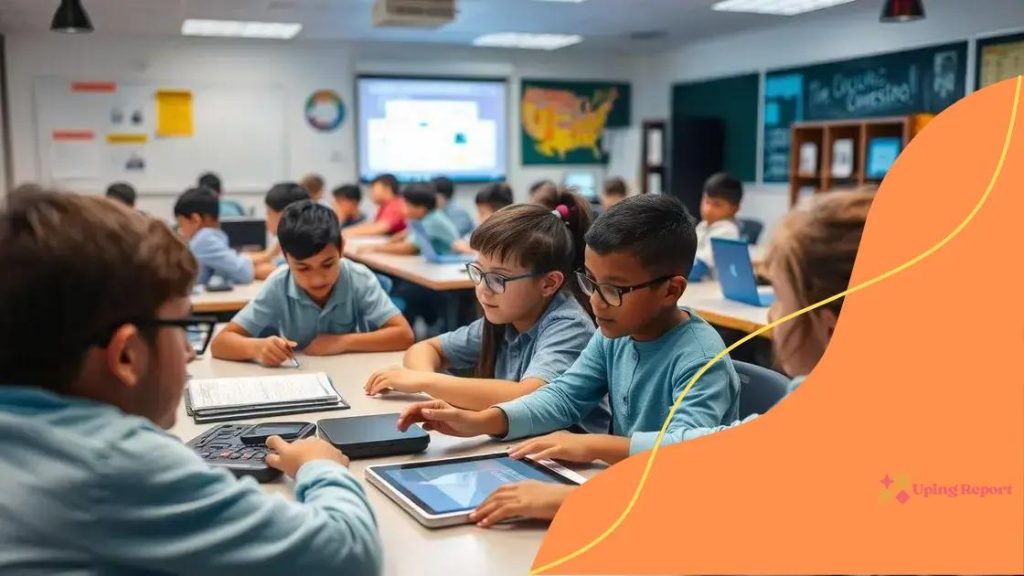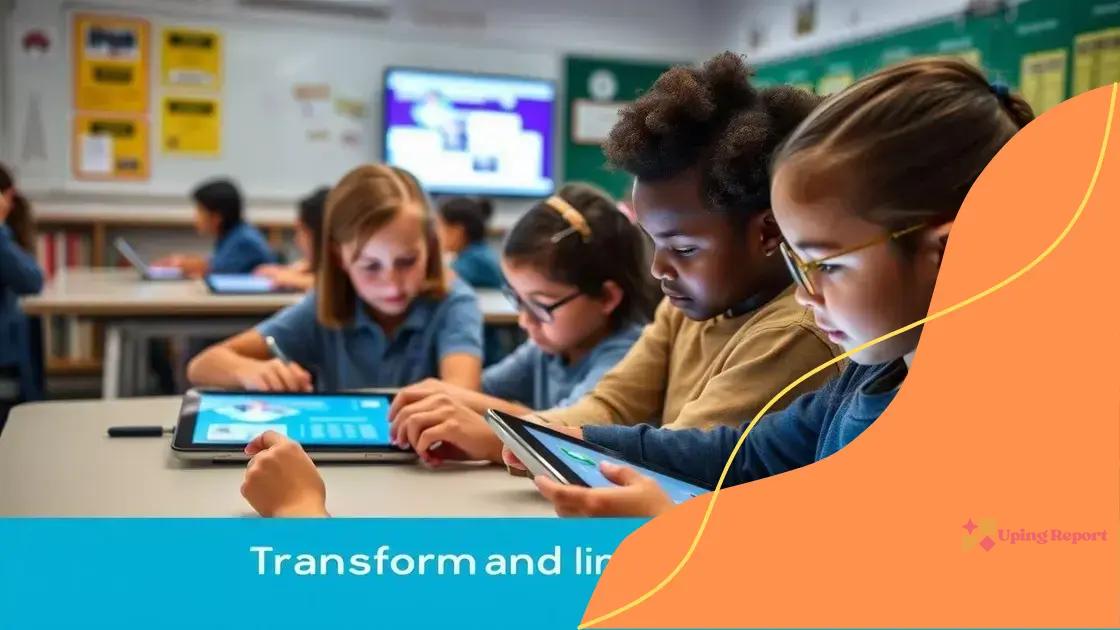AI education task force initiative: shaping the future of learning

The AI education task force initiative enhances learning by integrating personalized AI tools, improving engagement, and preparing students for future careers through innovative educational practices.
AI education task force initiative is at the forefront of revolutionizing how we approach learning today. With a focus on integrating technology into education, this initiative opens up exciting possibilities for students and teachers alike. Curious about what this means for the future of education? Let’s dive in!
Understanding the AI education task force initiative
The AI education task force initiative is designed to address the challenges in modern education. It aims to leverage artificial intelligence to enhance learning experiences for students of all ages. By focusing on innovative solutions, this initiative seeks to create enriching environments that promote engagement and understanding.
What the Initiative Entails
This initiative includes various strategies that educators and institutions can adopt. By integrating AI technologies, schools can offer personalized learning experiences that cater to students’ unique needs and learning paces.
- Development of tailored educational platforms.
- Use of AI to analyze student performance.
- Creation of interactive and immersive learning tools.
Furthermore, the AI education task force initiative promotes collaboration among educators, policymakers, and technology developers. This collaboration helps ensure that AI applications in education are effective and beneficial.
Benefits of the Initiative
The benefits of this initiative are manifold. It provides opportunities for students to engage with content in ways that were previously unimaginable. For instance, through AI-driven tools, learners can explore subjects at their own pace, making education more accessible.
- Enhanced student motivation and participation.
- Improved learning outcomes through adaptive learning technologies.
- Support for teachers with automated administrative tasks.
As we move forward, it’s essential to keep evaluating the impacts of the AI education task force initiative. Continuous assessment ensures that the technologies are meeting user needs effectively. By fostering an environment of innovation and adaptability, we can shape a brighter future for education.
Key objectives of the task force
The key objectives of the task force focus on transforming education through innovative practices. Each objective aims to provide tangible benefits for students, educators, and institutions alike. This initiative is designed to address various challenges that arise in traditional education systems.
Promoting Accessibility
One of the foremost aims is to promote accessibility in learning environments. By leveraging artificial intelligence, the task force seeks to offer personalized learning experiences that cater to diverse student needs. This ensures that all learners, regardless of background, can succeed.
- Developing adaptive learning platforms.
- Providing resources for underserved communities.
- Implementing AI tools to help students overcome learning barriers.
In addition, the task force emphasizes the importance of fostering collaboration among educators. This collaboration enables teachers to share resources and best practices, ultimately improving student outcomes.
Enhancing Engagement
Another significant objective is enhancing student engagement through technology. The task force aims to create interactive learning environments that captivate students’ attention. By utilizing AI, educators can develop dynamic content that resonates with students, making learning more exciting.
- Integrating gamification into educational content.
- Utilizing AI to analyze student interests.
- Offering varied learning methods to keep students engaged.
The key objectives of the task force also include equipping educators with the necessary tools to effectively utilize technology. Professional development programs are essential in this respect, empowering teachers to incorporate AI into their classrooms seamlessly. This holistic approach ensures that technology effectively supports education rather than complicates it.
How AI is transforming education

AI is profoundly changing the landscape of education. By integrating artificial intelligence into teaching methods, schools are discovering new ways to enhance learning experiences for students. This transformation is paving the way for more personalized, effective educational approaches.
Personalized Learning
One major benefit of AI in education is the ability to provide personalized learning. With AI tools, educators can tailor lessons to fit individual student needs. This customization helps students learn at their own pace and in a style that suits them best.
- Adaptive learning platforms adjust to student progress.
- AI-driven assessments provide instant feedback.
- Customized study plans to target specific areas of improvement.
Moreover, AI enhances engagement through interactive content. Students can learn through games and simulations that not only make learning fun but also deepen understanding of complex subjects.
Data-Driven Insights
Another significant aspect of AI is its capacity to analyze large amounts of data quickly. Educators can use data-driven insights to understand student performance better. This analysis allows teachers to identify trends and adjust their teaching strategies accordingly.
- Tracking student progress over time for better outcomes.
- Identifying at-risk students earlier.
- Making informed decisions on curriculum adjustments.
As more schools adopt AI technology, the collaboration between students and educators becomes more effective. AI fosters a supportive learning environment where both teacher and student can thrive.
Success stories from the initiative
The success stories from the initiative highlight the transformative impacts of AI in education. Various schools and districts have successfully implemented AI tools, leading to meaningful improvements in student engagement and learning outcomes.
Case Study: Personalized Learning in Action
One remarkable example is Oakwood High School, where AI technology was integrated into the curriculum. The school adopted a personalized learning platform that adjusts to each student’s pace. This system identifies individual strengths and weaknesses, providing tailored resources. As a result, students showed a significant increase in their test scores and overall motivation.
- Improved academic performance by over 30%.
- Higher levels of student satisfaction and engagement.
- Increased teacher efficiency through automated assessments.
Furthermore, the community noticed a reduction in dropout rates, proving the effectiveness of a supportive, customized learning environment.
Collaborative Projects
Another success story comes from a district-wide initiative where teachers collaborated with AI developers to integrate educational apps into their teaching. This collaboration led to the creation of interactive modules that engage students with real-world applications of their studies. The feedback from both teachers and students has been overwhelmingly positive.
- Engaged students through interactive simulations.
- Enhanced understanding of complex subjects.
- Fostering collaboration among educators.
The initiative not only improved academic outcomes but also created a culture of innovation within schools. These success stories underscore the potential of AI to reshape education for the better, paving the way for future advancements. By continuing to share these experiences, the initiative inspires more schools to embrace technology and reimagine their teaching methods.
Future implications for students and educators
The future implications for students and educators in light of the AI education task force initiative are vast and promising. As educational technology continues to evolve, both teachers and students will experience significant changes in their learning environments.
Embracing AI in Classrooms
One of the most notable implications is the integration of AI tools in everyday classroom practices. This means teachers will have access to resources that help them tailor their instruction more effectively. With AI handling administrative tasks, educators can focus more on teaching and engaging with their students.
- Streamlined curriculum development.
- Enhanced collaboration opportunities among teachers.
- Improved student feedback mechanisms.
As a result, educators can provide more personalized support to their students, ensuring that each learner’s unique needs are met.
Empowering Students
For students, the integration of AI in education will empower them to take control of their learning journeys. Students will have access to customized learning experiences and a wealth of resources. This encourages independence and fosters a deeper understanding of subjects they are studying.
- Increased access to diverse learning materials.
- Opportunities for collaborative projects using AI tools.
- Greater readiness for future careers influenced by technology.
Moreover, as education becomes more technology-oriented, students will develop essential skills needed for the workforce. They will learn how to interact with AI, analyze data, and think critically about information, making them more competitive in the job market.
FAQ – Frequently Asked Questions about AI in Education
How does AI enhance personalized learning for students?
AI analyzes individual student performance, allowing educators to tailor lessons and materials to meet diverse learning needs.
What are some ways teachers can benefit from using AI tools?
AI tools help streamline administrative tasks, provide instant feedback, and enable collaboration among teachers for improved lesson planning.
Can AI technology help prepare students for future careers?
Yes, by integrating AI into education, students develop critical skills such as data analysis, problem-solving, and adaptability that are essential in the workforce.
What impact does AI have on student engagement in the classroom?
AI creates interactive and immersive learning experiences, making lessons more engaging and relatable, which boosts student motivation and participation.
